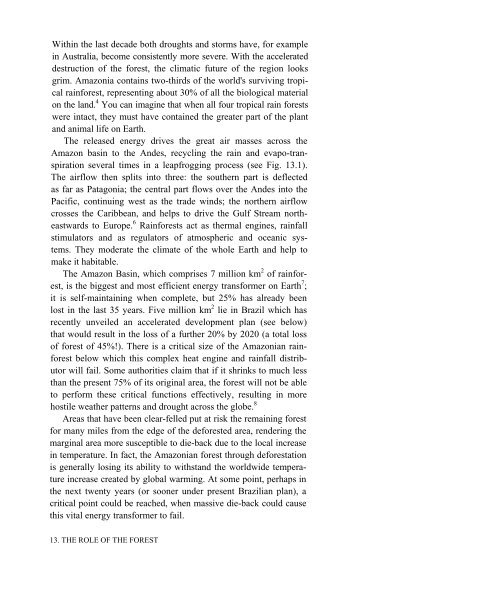levitational current - Free Energy
levitational current - Free Energy
levitational current - Free Energy
Create successful ePaper yourself
Turn your PDF publications into a flip-book with our unique Google optimized e-Paper software.
Within the last decade both droughts and storms have, for example<br />
in Australia, become consistently more severe. With the accelerated<br />
destruction of the forest, the climatic future of the region looks<br />
grim. Amazonia contains two-thirds of the world's surviving tropical<br />
rainforest, representing about 30% of all the biological material<br />
on the land. 4 You can imagine that when all four tropical rain forests<br />
were intact, they must have contained the greater part of the plant<br />
and animal life on Earth.<br />
The released energy drives the great air masses across the<br />
Amazon basin to the Andes, recycling the rain and evapo-transpiration<br />
several times in a leapfrogging process (see Fig. 13.1).<br />
The airflow then splits into three: the southern part is deflected<br />
as far as Patagonia; the central part flows over the Andes into the<br />
Pacific, continuing west as the trade winds; the northern airflow<br />
crosses the Caribbean, and helps to drive the Gulf Stream northeastwards<br />
to Europe. 6 Rainforests act as thermal engines, rainfall<br />
stimulators and as regulators of atmospheric and oceanic systems.<br />
They moderate the climate of the whole Earth and help to<br />
make it habitable.<br />
The Amazon Basin, which comprises 7 million km 2 of rainforest,<br />
is the biggest and most efficient energy transformer on Earth 7 ;<br />
it is self-maintaining when complete, but 25% has already been<br />
lost in the last 35 years. Five million km 2 lie in Brazil which has<br />
recently unveiled an accelerated development plan (see below)<br />
that would result in the loss of a further 20% by 2020 (a total loss<br />
of forest of 45%!). There is a critical size of the Amazonian rainforest<br />
below which this complex heat engine and rainfall distributor<br />
will fail. Some authorities claim that if it shrinks to much less<br />
than the present 75% of its original area, the forest will not be able<br />
to perform these critical functions effectively, resulting in more<br />
hostile weather patterns and drought across the globe. 8<br />
Areas that have been clear-felled put at risk the remaining forest<br />
for many miles from the edge of the deforested area, rendering the<br />
marginal area more susceptible to die-back due to the local increase<br />
in temperature. In fact, the Amazonian forest through deforestation<br />
is generally losing its ability to withstand the worldwide temperature<br />
increase created by global warming. At some point, perhaps in<br />
the next twenty years (or sooner under present Brazilian plan), a<br />
critical point could be reached, when massive die-back could cause<br />
this vital energy transformer to fail.<br />
13. THE ROLE OF THE FOREST








![The Big Lie 9-11 and Government Complicity in Mass Murder [PDF]](https://img.yumpu.com/50957077/1/190x245/the-big-lie-9-11-and-government-complicity-in-mass-murder-pdf.jpg?quality=85)








